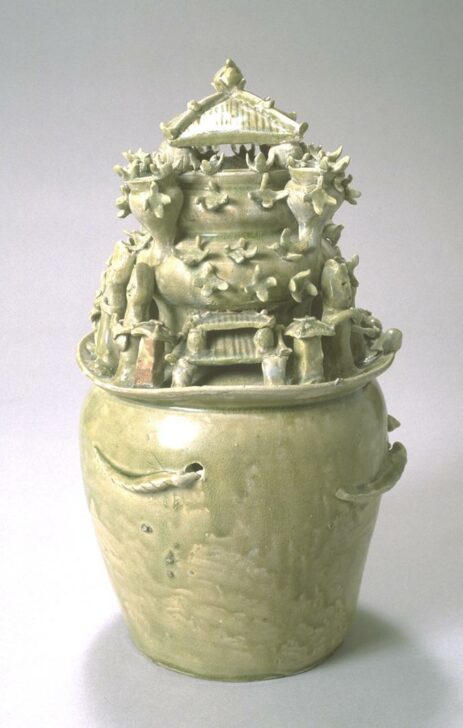Funerary Jar
Chinese

Description
Gallery Rotation Summer 2013
Proto-Yue ware Hunping funerary jar
China, Zhejiang province, Western Jin dynasty, 265–316
3rd century
Stoneware with celadon glaze
Museum purchase made possible by a gift from William and Martha Steen, 2000/1.39
This charming pot, with its engaging depiction of musicians and flocks of birds gathered by a many-roofed structure, bears silent witness to a tragic period in Chinese history. In the early fourth century, invasions by nomadic raiders from the steppes to the west forced tens of thousands of Chinese to flee southward. Aside from the terrible toll of lives lost, the surviving exiles could not provide proper tombs for deceased family members. Instead, they sought to appease the souls of the departed by providing a resting place in ceramic containers such as this one, known as a hunping (jar for the soul). The jar is made of grey stoneware with a coat of green glaze typical of Yue wares. The glaze is an early form of celadon that is thin, lustrous, and evenly vitreous. It is the precursor to the renowned translucent celadon glazes of the Song dynasty (960–1279).
The structure on the lid presents a square building within a circular enclosure, reminiscent of an ancient Chinese practice of using a jade bi and cong to symbolize the joining of heaven and earth; these symbols suggests the jar is a fitting home for wandering souls. It is also possible that the hunping form was inspired by Buddhist reliquaries or containers for the ashes of the deceased; the gate (the two roofed pillars at the base of the tower) would then symbolize the boundary to the Buddhist paradise. The overlapping of meanings was common during this period in Chinese history.
Subject Matter:
A hunping funerary jar of the Western Jin dynasty (265-317).
This hunping (混瓶), or ‘jar for the soul’, with celadon glaze possesses an assortment of figures and architecture in a tiered arrangement. The hunping reflects the southern tradition of "burial of the summoned soul." Placed in a tomb together with armrests, banqueting tables, food, and drink, it was hoped that the soul of the deceased would return to reside in the urn, entering, in this particular case, through the gate that appears to lead directly into the vessel. The auspicious birds and figures represent mystical entities that could guide the soul to be reborn in paradise.
This charming pot, with its engaging depiction of musicians and flocks of birds gathered by a many-roofed structure, bears silent witness to a tragic period in Chinese history. In the early fourth century, invasions by nomadic raiders from the steppes to the west forced tens of thousands of Chinese to flee southward. Aside from the terrible toll of lives lost, the surviving exiles could not provide proper tombs for deceased family members. Instead, they sought to appease the souls of the departed by providing a resting place in ceramic containers such as this one, known as a hunping, or “jar for the soul.”
The structure on the lid presents a square building within a circular enclosure, reminiscent of an ancient Chinese formula using a jade bi and cong to symbolize the joining of earth and heaven, and thus fitting as a home for wandering souls. It is also possible that the hunping form may have been inspired by Buddhist reliquaries or containers for the ashes of the deceased; the gate (the two roofed pillars at the base of the tower) would then symbolize the boundary to Buddhist paradise. The two overlapping meanings were common during this period in Chinese history. The jar is made of grey stoneware with a coat of green glaze typical of Yue wares. The glaze is an early form of celadon that is thin, lustrous, and evenly vitreous. It is the precursor to the renowned, later translucent celadon glazes of the Song dynasty (960-1279).
Physical Description:
A large stoneware jar with a slightly tapered body, wide shoulders and a wide flaring mouth. There are smaller jars stacked on top, getting progressively smaller, topped with a hipped roof mimicking contemporary architectural features and additional architectural features such as towers around the mouth and a plethora of assorted figures, birds, and cosmological animals applied around the top half of the vessel. It is covered in a grey-green celadon glaze.
Usage Rights:
If you are interested in using an image for a publication, please visit https://umma.umich.edu/request-image/ for more information and to fill out the online Image Rights and Reproductions Request Form.